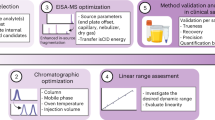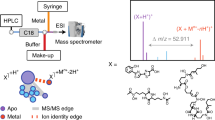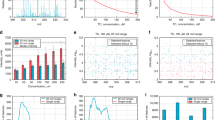Abstract
Stable isotopes of carbon, hydrogen, nitrogen, oxygen and sulfur are widespread in nature. Nevertheless, their relative abundance is not the same everywhere. This is due to kinetic isotope effects in enzymes and other physical principles such as equilibrium thermodynamics. Variations in isotope ratios offer unique insights into environmental pollution, trophic relationships in ecology, metabolic disorders and Earth history including climate history. Although classical isotope ratio mass spectrometry (IRMS) techniques still struggle to access intramolecular information like site-specific isotope abundance, electrospray ionization–Orbitrap mass spectrometry can be used to achieve precise and accurate intramolecular quantification of isotopically substituted molecules (‘isotopocules’). This protocol describes two procedures. In the first one, we provide a step-by-step beginner’s guide for performing multi-elemental, intramolecular and site-specific stable isotope analysis in unlabeled polar solutes by direct infusion. Using a widely available calibration solution, isotopocules of trifluoroacetic acid and immonium ions from the model peptide MRFA are quantified. In the second approach, nitrate is used as a simple model for a flow injection routine that enables access to a diverse range of naturally occurring isotopic signatures in inorganic oxyanions. Each procedure takes 2–3 h to complete and requires expertise only in general mass spectrometry. The workflows use optimized Orbitrap IRMS data-extraction and -processing software and are transferable to various analytes amenable to soft ionization, including metabolites, peptides, drugs and environmental pollutants. Optimized mass spectrometry systems will enable intramolecular isotope research in many areas of biology.
Key points
-
Carbon, hydrogen, nitrogen, oxygen and sulfur have naturally occurring stable isotopes. Variations in their relative distribution within molecules can provide information relevant to environmental biology, metabolism, food and drug origins and climate history.
-
This protocol describes how to use electrospray ionization–Orbitrap mass spectrometry to achieve precise and accurate molecular quantification of isotopically substituted molecules (‘isotopocules’). It serves as a citable reference for optimized Orbitrap IRMS data-extraction and -processing software.
This is a preview of subscription content, access via your institution
Access options
Access Nature and 54 other Nature Portfolio journals
Get Nature+, our best-value online-access subscription
$29.99 / 30 days
cancel any time
Subscribe to this journal
Receive 12 print issues and online access
$259.00 per year
only $21.58 per issue
Buy this article
- Purchase on Springer Link
- Instant access to full article PDF
Prices may be subject to local taxes which are calculated during checkout












Similar content being viewed by others
Data availability
The raw data supporting the findings of this study have been deposited to the MassIVE repositories with accession codes MSV000093222 (Procedure 1) and MSV000093223 (Procedure 2). Source data, data processing scripts and output plots and tables are available via a GitHub repository at github.com/isoverse/2023_kantnerova_et_al. Source data are provided with this paper.
Code availability
The isoorbi R package can be found at isoorbi.isoverse.org, github.com/isoverse/isoorbi and cloud.r-project.org/package=isoorbi. The IsoXL demo GUI can be found at isoorbi.isoverse.org/articles/isoxl_demo.html.
References
Brenna, J. T. Natural intramolecular isotope measurements in physiology: elements of the case for an effort toward high-precision position-specific isotope analysis. Rapid Commun. Mass Spectrom. 15, 1252–1262 (2001).
Eiler, J. M. The isotopic anatomies of molecules and minerals. Annu. Rev. Earth Planet. Sci. 41, 411–441 (2013).
Gilbert, A. The organic isotopologue frontier. Annu. Rev. Earth Planet. Sci. 49, 435–464 (2021).
Hinrichs, K.-U., Eglinton, G., Engel, M. H. & Summons, R. E. Exploiting the multivariate isotopic nature of organic compounds. Geochem., Geophys., Geosyst. 2, 1052 (2001).
Piper, T., Geyer, H., Nieschlag, E., Bally, L. & Thevis, M. Carbon isotope ratios of endogenous steroids found in human serum—method development, validation, and reference population-derived thresholds. Anal. Bioanal. Chem. 413, 5655–5667 (2021).
Guyader, S. et al. Combination of 13C and 2H SNIF-NMR isotopic fingerprints of vanillin to control its precursors. Flavour Fragr. J. 34, 133–144 (2019).
O’Brien, D. M. Stable isotope ratios as biomarkers of diet for health research. Annu. Rev. Nutr. 35, 565–594 (2015).
Kaiser, J. & Röckmann, T. Correction of mass spectrometric isotope ratio measurements for isobaric isotopologues of O2, CO, CO2, N2O and SO2. Rapid Commun. Mass Spectrom. 22, 3997–4008 (2008).
Neubauer, C. et al. Discovering nature’s fingerprints: isotope ratio analysis on bioanalytical mass spectrometers. J. Am. Soc. Mass Spectrom. 34, 525–537 (2023).
Murray, K. K. et al. Definitions of terms relating to mass spectrometry (IUPAC Recommendations 2013). Pure Appl. Chem. 85, 1515–1609 (2013).
Christen, A. Atmospheric measurement techniques to quantify greenhouse gas emissions from cities. Urban Clim. 10, 241–260 (2014).
Fry, B., Carter, J. F., Yamada, K., Yoshida, N. & Juchelka, D. Position‐specific 13C/12C analysis of amino acid carboxyl groups – automated flow‐injection analysis based on reaction with ninhydrin. Rapid Commun. Mass Spectrom. 32, 992–1000 (2018).
Akoka, S. & Remaud, G. S. NMR-based isotopic and isotopomic analysis. Prog. Nucl. Magn. Reson. Spectrosc. 120–121, 1–24 (2020).
Neubauer, C. et al. Towards measuring growth rates of pathogens during infections by D2O-labeling lipidomics. Rapid Commun. Mass Spectrom. 32, 2129–2140 (2018).
Neubauer, C. et al. Scanning the isotopic structure of molecules by tandem mass spectrometry. Int. J. Mass Spectrom. 434, 276–286 (2018).
Eiler, J. et al. Analysis of molecular isotopic structures at high precision and accuracy by Orbitrap mass spectrometry. Int. J. Mass Spectrom. 422, 126–142 (2017).
Hilkert, A. et al. Exploring the potential of electrospray-Orbitrap for stable isotope analysis using nitrate as a model. Anal. Chem. 93, 9139–9148 (2021).
Gharibi, H. et al. Proteomics-compatible Fourier Transform isotopic ratio mass spectrometry of polypeptides. Anal. Chem. 94, 15048–15056 (2022).
Neubauer, C. et al. Stable isotope analysis of intact oxyanions using electrospray quadrupole-Orbitrap mass spectrometry. Anal. Chem. 92, 3077–3085 (2020).
Abelson, P. H. & Hoering, T. C. Carbon isotope fractionation in formation of amino acids by photosynthetic organisms. Proc. Natl Acad. Sci. USA 47, 623–632 (1961).
Fronza, G., Fuganti, C., Schmidt, H. L. & Werner, R. A. The δ18O-value of the p-OH group of L-tyrosine permits the assignment of its origin to plant or animal sources. Eur. Food Res. Technol. 215, 55–58 (2002).
Eiler, J. M. “Clumped-isotope” geochemistry—the study of naturally-occurring, multiply-substituted isotopologues. Earth Planet. Sci. Lett. 262, 309–327 (2007).
Jang, C., Chen, L. & Rabinowitz, J. D. Metabolomics and isotope tracing. Cell 173, 822–837 (2018).
Angel, T. E., Naylor, B. C., Price, J. C., Evans, C. & Szapacs, M. Improved sensitivity for protein turnover quantification by monitoring immonium ion isotopologue abundance. Anal. Chem. 91, 9732–9740 (2019).
Su, X., Lu, W. & Rabinowitz, J. D. Metabolite spectral accuracy on Orbitraps. Anal. Chem. 89, 5940–5948 (2017).
Llufrio, E. M., Cho, K. & Patti, G. J. Systems-level analysis of isotopic labeling in untargeted metabolomic data by X13CMS. Nat. Protoc. 14, 1970–1990 (2019).
Granger, J. & Wankel, S. D. Isotopic overprinting of nitrification on denitrification as a ubiquitous and unifying feature of environmental nitrogen cycling. Proc. Natl Acad. Sci. USA 113, E6391–E6400 (2016).
Mueller, E. P., Sessions, A. L., Sauer, P. E., Weiss, G. M. & Eiler, J. M. Simultaneous, high-precision measurements of δ2H and δ13C in nanomole quantities of acetate using electrospray ionization-quadrupole-Orbitrap mass spectrometry. Anal. Chem. 94, 1092–1100 (2022).
Hofmann, A. E. et al. Using Orbitrap mass spectrometry to assess the isotopic compositions of individual compounds in mixtures. Int. J. Mass Spectrom. 457, 116410 (2020).
Csernica, T., Bhattacharjee, S. & Eiler, J. Accuracy and precision of ESI-Orbitrap-IRMS observations of hours to tens of hours via reservoir injection. Int. J. Mass Spectrom. 490, 117084 (2023).
Peng, Y., Wang, Z. & Bao, H. Oxygen isotope analysis of phosphate by Electrospray Orbitrap mass spectrometry. AGU Fall Meet. Abstr. 2022, V32B-0080 (2022).
Gharibi, H. et al. Abnormal (hydroxy)proline deuterium content redefines hydrogen chemical mass. J. Am. Chem. Soc. 144, 2484–2487 (2022).
Wilkes, E. B. et al. Position-specific carbon isotope analysis of serine by gas chromatography/Orbitrap mass spectrometry, and an application to plant metabolism. Rapid Commun. Mass Spectrom. 36, e9347 (2022).
Cesar, J., Eiler, J., Dallas, B., Chimiak, L. & Grice, K. Isotope heterogeneity in ethyltoluenes from Australian condensates, and their stable carbon site-specific isotope analysis. Org. Geochem. 135, 32–37 (2019).
Zeichner, S. S. et al. Methods and limitations of stable isotope measurements via direct elution of chromatographic peaks using gas chromatography-Orbitrap mass spectrometry. Int. J. Mass Spectrom. 477, 116848 (2022).
MacCoss, M. J., Toth, M. J. & Matthews, D. E. Evaluation and optimization of ion-current ratio measurements by selected-ion-monitoring mass spectrometry. Anal. Chem. 73, 2976–2984 (2001).
Kharchenko, A., Vladimirov, G., Heeren, R. M. A. & Nikolaev, E. N. Performance of Orbitrap mass analyzer at various space charge and non-ideal field conditions: simulation approach. J. Am. Soc. Mass Spectrom. 23, 977–987 (2012).
Gorshkov, M. V., Fornelli, L. & Tsybin, Y. O. Observation of ion coalescence in Orbitrap Fourier transform mass spectrometry. Rapid Commun. Mass Spectrom. 26, 1711–1717 (2012).
Grinfeld, D. et al. Space-charge dynamics in Orbitrap mass spectrometers. Int. J. Mod. Phys. A 34, 1942007 (2019).
Wang, Y., Sessions, A. L., Nielsen, R. J. & Goddard, W. A. Equilibrium 2H/1H fractionations in organic molecules: I. Experimental calibration of ab initio calculations. Geochim. Cosmochim. Acta 73, 7060–7075 (2009).
Silverman, S. N. et al. Practical considerations for amino acid isotope analysis. Org. Geochem. 164, 104345 (2022).
Claesen, J., Rockwood, A., Gorshkov, M. & Valkenborg, D. The isotope distribution: a rose with thorns. Mass Spectrom. Rev. https://doi.org/10.1002/mas.21820 (2023).
Taylor, P. J. Matrix effects: the Achilles heel of quantitative high-performance liquid chromatography-electrospray-tandem mass spectrometry. Clin. Biochem. 38, 328–334 (2005).
Skrzypek, G. et al. Minimum requirements for publishing hydrogen, carbon, nitrogen, oxygen and sulfur stable-isotope delta results (IUPAC Technical Report). Pure Appl. Chem. 94, 1249–1255 (2022).
Makarov, A., Denisov, E. & Lange, O. Performance evaluation of a high-field Orbitrap mass analyzer. J. Am. Soc. Mass Spectrom. 20, 1391–1396 (2009).
Acknowledgements
K.K. was supported by the Swiss National Science Foundation (Project No. P500PN_206702). Parts of this protocol build on work enabled by a grant from the National Science Foundation (Award no. 2041539) to S.K. and C.N. We thank J. K. Böhlke for fruitful discussions about referencing of stable-isotope data and access to reference materials and K. Aizikov for guidance on programming IsoX. We also thank B. Davidheiser, A. Angert, N. Bernet, H. Hayen, R. Marks, S. Ono and L. Yu for their critical feedback on the draft manuscript and software.
Author information
Authors and Affiliations
Contributions
All co-authors conceived, designed and developed the protocol. K.K., N.K. and C.N. performed the experiments, analyzed the data and wrote the manuscript. K.K., N.K., C.N. and S.K. prepared the data analysis scripts and software. D.J., A.H. and S.K. edited the manuscript. All co-authors read, commented on and accepted the final manuscript.
Corresponding author
Ethics declarations
Competing interests
The authors declare the following competing financial interest(s). A.H. and D.J. are employees of Thermo Fisher Scientific GmbH, which manufactures Orbitrap mass spectrometers as well as gas-source isotope ratio mass spectrometers. N.K. is a PhD student at the University of Münster and is conducting his doctoral thesis employed as a PhD student/R&D scientist at Thermo Fisher Scientific GmbH on Orbitrap-based isotope ratio measurements. C.N. is a paid independent scientific consultant to Thermo Fisher Scientific Inc. for ESI-Orbitrap mass spectrometer–based isotope ratio measurements.
Peer review
Peer review information
Nature Protocols thanks Amy Hofmann, Yongbo Peng, Matthias Pilecky and the other, anonymous, reviewer(s) for their contribution to the peer review of this work.
Additional information
Publisher’s note Springer Nature remains neutral with regard to jurisdictional claims in published maps and institutional affiliations.
Related links
Key references using this protocol
Eiler, J. et al. Int. J. Mass Spectrom. 422, 126–142 (2017): https://doi.org/10.1016/j.ijms.2017.10.002
Neubauer, C. et al. Int. J. Mass Spectrom. 434, 276–286 (2018): https://doi.org/10.1016/j.ijms.2018.08.001
Hilkert, A. et al. Anal. Chem. 93, 9139–9148 (2021): https://doi.org/10.1021/acs.analchem.1c00944
Jang, C. et al. Cell 173, 822–837 (2018): https://doi.org/10.1016/j.cell.2018.03.055
Neubauer, C. et al. J. Am. Soc. Mass Spectrom. 34, 525–537 (2023): https://doi.org/10.1021/jasms.2c00363
Extended data
Extended Data Fig. 1 Screenshot of a sequence file.
This example shows the sequence to analyze nitrate by using the described flow injection method (USGS35: standard; USGS32: sample). Injections of USGS35 at the beginning of the sequence for equilibration are not shown.
Extended Data Fig. 2
Structure of the isotopologs.tsv file for TFA.
Extended Data Fig. 3
Structure of the isotopologs.tsv file for immonium ions from MRFA.
Extended Data Fig. 4 Screenshot of a RAW file.
The screenshot is from the FreeStyle software, showing the signal intensity (top) and the mass spectrum (bottom) for the flow injection analysis of nitrate during the stable signal plateau.
Extended Data Fig. 5
Structure of the isotopologs.tsv file for nitrate.
Extended Data Fig. 6 Shot-noise plots for TFA.
a and b, Data for the isotopocule ratios 13C/M0 (a) and 18O/M0 (b). The data were obtained with two AGC target settings that resulted in different ITs: AGC target of 104 with IT = 0.03 ms (green, suboptimal) and AGC target of 106 with IT = 0.75 ms (orange, optimal). The optimal settings result in better precision (relative standard error, data points) within the same time, compared to the suboptimal settings. The lines depict the theoretical shot-noise limit.
Extended Data Fig. 7 Shot-noise plots for TFA.
a and b, Data for the isotopocule ratios 13C/M0 (a) and 18O/M0 (b). The data were obtained with two Orbitrap resolution settings: 120,000 (green, suboptimal) and 15,000 (orange, optimal). The optimal settings result in better precision (relative standard error, data points) within the same time, compared to the suboptimal settings. The lines depict the theoretical shot-noise limit.
Extended Data Fig. 8 Shot-noise plots for isotopocule ratios of immonium ions created from the MRFA peptide.
a–d, Alanine (a), arginine (b), methionine (c) and phenylalanine (d). The plots show decreasing relative standard error (the points) during the analysis time, which follows the theoretical shot-noise limit (lines). The offset between the individual isotopocules is based on their relative abundance (13C/12C has the highest isotopic abundance ratio, whereas 2H/1H has the lowest).
Supplementary information
Supplementary Information
Supplementary Notes 1 and 2, Supplementary Tables 1–11, Supplementary Figs. 1–21 and Supplementary Data.
Supplementary Data
A spreadsheet showing the implementation of alternative ways to do the one-point calibration of δ values.
Source data
Source Data Fig. 10
Shot-noise data for 13C- and 18O-isotopocules of TFA.
Source Data Fig. 11
Extracted ion currents for four amino acid immonium ions and ratios of 13C/M0 for every replicate.
Source Data Fig. 12
Extracted ion currents for nitrate injections, ratios of 18O/M0 during the injections and ratios of 18O/M0 for every injection and d18O.
Source Data Extended Data Fig. 6
Shot-noise data for 13C- and 18O-isotopocules of TFA with different AGC target settings.
Source Data Extended Data Fig. 7
Shot-noise data for 13C- and 18O-isotopocules of TFA with different Orbitrap resolution settings.
Source Data Extended Data Fig. 8
Shot-noise data for immonium ions from the MRFA peptide.
Rights and permissions
Springer Nature or its licensor (e.g. a society or other partner) holds exclusive rights to this article under a publishing agreement with the author(s) or other rightsholder(s); author self-archiving of the accepted manuscript version of this article is solely governed by the terms of such publishing agreement and applicable law.
About this article
Cite this article
Kantnerová, K., Kuhlbusch, N., Juchelka, D. et al. A guide to precise measurements of isotope abundance by ESI-Orbitrap MS. Nat Protoc (2024). https://doi.org/10.1038/s41596-024-00981-5
Received:
Accepted:
Published:
DOI: https://doi.org/10.1038/s41596-024-00981-5
Comments
By submitting a comment you agree to abide by our Terms and Community Guidelines. If you find something abusive or that does not comply with our terms or guidelines please flag it as inappropriate.



